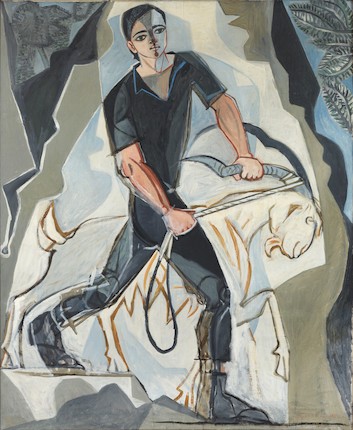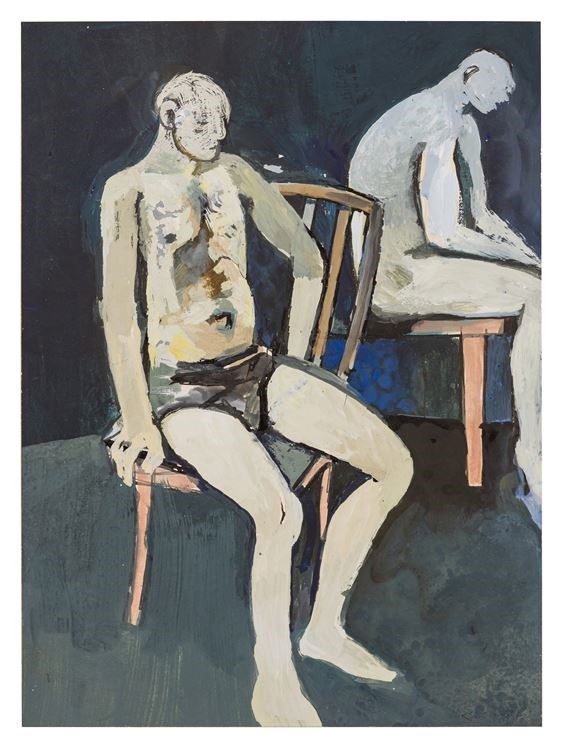In response to what my friend Max thought I would interpret as a rhetorical query, as to whether we’re still buying artwork, my answer was that we yet have space where the walls are adjacent to the floor, so plenty of stacking room. Mind, there are collectors and there are those who aren’t. A collector and I claim unashamedly to be one, is always collecting.
There are those whose range of collections is narrow. One particular artist, one particular school, one particular medium. I term that kind a constipated collector. My innards are in good working order, and as such, our collecting habits are varied and regular. In case you were worried, the scatology ends here.

exhibited Pallant House, Chichester, 2023‘
John Craxton: A Modern Odyssey’
Image courtesy Bonhams
Lest you think we’re entirely unrestrained, we do have some particular areas- British modernists and ukiyo-e most prominent. These two areas are not so disparate, as the likes of Duncan Grant and Vanessa Bell – two artists we collect- were not unlike impressionists of a generation earlier in borrowing colours and general themes from the Japanese woodblock prints that made their way into Europe from the 1870s. A surprising booty, worthless ephemera in Japan, the prints served to wrap and protect against damage Japanese porcelains and earthenware shipped to the west.
In further restraint, we do apply the same rubrics as we always have- an object must be a confluence of quality, condition, and price. Price, indeed, as so much of what’s out there to collect is in sufficient quantity we can consider it a fungible commodity. If my gentle readers need a reminder, Keith McCullar is an accountant and I spent decades in the banking business so money remains a primary loyalty- and we do in whatever we purchase expect good value for it.
That we do, with a reluctance to as it were splash out, happens to allow our acquisitions to proceed apace. Unless, of course, an artist we happen to collect is having a moment. A well-received monographic exhibition, for instance, can cause an escalation in prices that may be short lived. Right now, for instance, the artist John Craxton is having one such, apropos the wonderful monographic exhibition that ran late last year at Pallant House in Chichester. A painting from that exhibition is on offer at auction as I write this, estimated into the low six figures. We’ll see how it does.
Also in the same sale are a number of pictures by Keith Vaughn, one of which, I’ll admit, I had an eye on, until I actually inspected it, that is. Vaughn’s prolific output very much ran to pattern- similar pallet, similar angularity to the figures, which tended to run to depictions of nude men. An artist in the tortured homosexual class, his own homoerotic images were, although nude, fairly chaste. Angular, with flattened perspective, and largely absent of genitalia.

Gouache and ink on paper
Image courtesy of Chiswick Auctions
For reasons that I do not know, Vaughn too is having a moment. Pallant House had an excellent monographic exhibition of his work, on the centenary of his birth, but that exhibition was in 2012. But looking at one of the databases we normally consult, there has over the last couple of years been an almost five-fold increase in the number of Vaughn’s works that have passed through the salerooms, driven by an unaccountable increase in the value of the works on offer.
Not surprising, price increases bring works by an artist out of the woodwork, with owners, including more than a few dealers, seeking to cash in. That’s the good part. The bad part is, it also brings to the market a fair number- I won’t say fakes because I don’t want to be sued- but shall we say ‘enhanced’ images. Did I say no penises? Well all of a sudden, they are there a plenty, plumped up a bit for effect. One would not know, looking solely at so many of these travesties that Vaughn was indeed deeply troubled by his sexuality which no doubt contributed, along with ill health, to his ultimate suicide in 1977. Erotically suggestive, but chaste in their way, a visual reticence that perhaps reflected Vaughn’s own sexual stricture.
But now, in the age of the overt, visual eroticism if it means anything it means everything on view, and Vaughn’s visual restraint is not to the taste of the buyer of the present day. Everything that used to be a shaded sexual byway is now labelled queer, whether it is so or not. And I presume the penchant for queerness is at least partially driving interest in Keith Vaughn. With his standard palette of greys and greens and typically small size of the support for his very many gouaches that have made their way onto the retail market of late, fairly easy to, shall we say, enhance. With a bit of water as a diluent, the pigment at the top of an appropriate figure’s pelvic ‘v’ can be dissolved and then shall we say anatomically strengthened with a few strokes of the brush.
Having a moment, and for all that’s resulted, I’ll be avoiding Keith Vaughn for the next little while.
